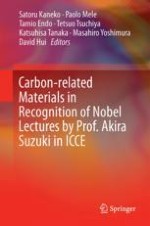This book summarizes the recent advances in carbon-related materials. It covers both experimental and theoretical approaches in graphene and nanocarbon materials, carbon composites and thin films, organic synthesis and physical chemistry, and characterization tools. Also discussed are cutting-edge applications for use in biochemical assays, dental implant surface modifi cations, pressure sensors, and more. This book is published in recognition of the Nobel Lectures delivered by Akira Suzuki, Emeritus Professor of Hokkaido University and Nobel Prize winner in Chemistry, 2010.
